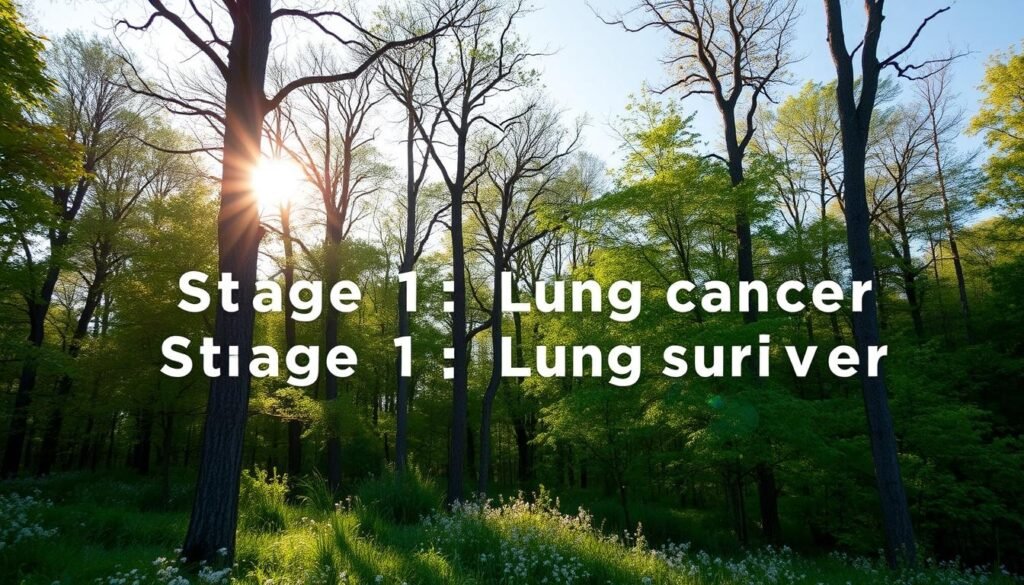Surgery is a key treatment for early lung cancer, specifically for stage 1 non–small cell lung cancer (NSCLC). This is if the patient is healthy enough for the procedure. Knowing the options for lung cancer treatment at this stage is crucial. It helps patients and families understand the surgical paths available.
For stage 1 NSCLC, surgery aims to remove the tumor. This gives patients one of the best chances to get rid of the cancer completely. Among the surgeries, lobectomy is the most common. With new advances, doctors have more ways to fight cancer. It is important for patients to talk with their doctors about these options.
This article discusses different surgeries for early-stage lung cancer and what patients can expect afterward. Learning about surgery for early-stage lung cancer is key to better recovery chances. It helps in improving patients’ overall health outlook.
Key Takeaways
- Surgery is often the primary treatment for stage 1 non-small cell lung cancer.
- Lobectomy offers the best chance for complete cancer removal.
- Alternative treatments may include radiation therapy or chemotherapy, depending on individual cases.
- The choice of surgical procedure can significantly impact recovery outcomes.
- Postoperative treatments can enhance survival rates for some patients.
Understanding Lung Cancer Staging
Lung cancer is sorted into stages to plan the right treatment. There are four main lung cancer stages, from stage 1 to stage 4. Stage 1 means the cancer hasn’t grown outside the original area, shown by a small tumor that hasn’t spread to nearby tissues or lymph nodes. This stage is also split into 1A and 1B for more precise treatment.
Stage 1A is further divided into 1A1, 1A2, and 1A3, based on tumor size and more. Tumors in stage 1A are usually no bigger than 4 centimeters and stay inside the lung. However, stage 1B tumors might be between 3 cm and 4 cm or have spread to certain lung parts, causing problems like collapse or inflammation.
The classification of lung cancer depends on the TNM system. This includes looking at the tumor size (T), if it has reached the lymph nodes (N), and whether it has spread far (M). Stage 1A matches T1a-c, N0, M0, while stage 1B fits T2a, N0, M0. Knowing these stages helps doctors choose the best treatment.
Understanding these stages helps doctors pick treatments like surgery, chemotherapy, or radiotherapy, based on how severe the cancer is. Non-small cell lung cancer is often found early, unlike small cell lung cancer, which is usually found at later stages. This early discovery offers more treatment options and a chance at better outcomes.
Knowing the exact stage helps make sure treatment is well-suited to the patient’s situation. This leads to the best care and strategy for managing their health.
Overview of Stage 1 Non-Small Cell Lung Cancer
Stage 1 non-small cell lung cancer (NSCLC) is a key category of lung cancer. It means the cancer hasn’t spread beyond the lung. This early stage is split into stage 1A and stage 1B. In stage 1A, the tumor is 3 cm small or less. This stage is further broken down into groups 1A1, 1A2, and 1A3, depending on how big the tumor is.
On the other hand, stage 1B tumors are bigger than 3 cm but don’t get larger than 4 cm. Sometimes, these can grow in ways that affect structures close to them.
People found with NSCLC at this stage usually are in good health. This makes them great candidates for surgery. Their treatment might also include targeted therapy, chemotherapy, or radiation. The American Cancer Society says the survival rate for this stage is around 64 percent. This shows why finding the cancer early and treating it fast is important.
Symptoms like coughing a lot, feeling short of breath, or having chest pain can lead someone to see a doctor. Then, doctors might use scans and biopsies to check if it’s lung cancer. These steps help them figure out if someone has NSCLC.
| Sub-Stages | Tumor Size | Location | Growth Characteristics |
|---|---|---|---|
| Stage 1A1 | ≤ 3 cm | Confined to the lung | Minimally invasive adenocarcinoma |
| Stage 1A2 | 1 cm – 2 cm | Confined to the lung | No spread to lymph nodes |
| Stage 1A3 | 2 cm – 3 cm | Confined to the lung | No spread to lymph nodes |
| Stage 1B | 3 cm – 4 cm | Confined to the lung | Potential spread to main bronchus or lung membrane |
Surgery for Lung Cancer Stage 1: Treatment Options
Surgery is key in treating Stage 1 lung cancer, especially since many have non-small cell lung cancer (NSCLC). At this stage, there are several surgical options for stage 1 lung cancer. Each aims to remove the tumor and save as much lung function as possible.
What Is Involved in Stage 1 Surgery?
Stage 1 surgery can include a lobectomy, wedge resection, or segmentectomy. Before surgery, doctors check the lung’s function and the patient’s overall health. Here’s what typically happens:
- They take out the tumor and some healthy tissue around it.
- The lymph nodes are checked to see if the cancer spread.
- They may use techniques like Video-Assisted Thoracoscopic Surgery (VATS) for less invasive surgery.
Doctors suggest planning before surgery to improve the chances of success.
Expected Outcomes of Surgical Treatment
Early detection makes lung cancer surgery outcomes very hopeful. For Stage I patients, survival rates five years after can top 65%. Each sub-stage has different survival rates:
| Stage | 5-Year Survival Rate |
|---|---|
| IA1 | 92% |
| IA2 | 83% |
| IB | 68% |
With early surgery, cure rates can reach 80% to 90%, highlighting early detection’s importance. After surgery, additional treatments might help recovery and lower the chance of the cancer coming back.
Types of Surgical Procedures for Stage 1 Lung Cancer
For stage 1 lung cancer, surgery is a key treatment option. There are different surgeries for different needs and cancer types. Choosing the right surgery means knowing the available techniques and their risks and benefits.
Lobectomy: The Standard Procedure
Lobectomy is the top choice for treating stage 1 lung cancer. It removes an entire lung lobe, taking out all the cancer. It’s best for patients with tumors that haven’t spread, saving a lot of lung function. Sometimes, if needed, two lobes can be removed in a bilobectomy.
Wedge Resection vs. Segmentectomy
Wedge resection and segmentectomy are for small, definite tumors. Wedge resection cuts out a small, triangle-shaped piece of lung around the tumor. This keeps most of the lung intact. Segmentectomy removes a whole lobe segment for better lung function while still removing the cancer.
Sleeve Resection for Specific Cases
Sleeve resection is used when the tumor is close to major airways. It takes out part of the airway and the tumor, then rebuilds the airway. This method is great for keeping lung function up and stopping cancer spread, depending on where the tumor is.
| Procedure | Description | Indications |
|---|---|---|
| Lobectomy | Removal of an entire lobe of the lung | Localized tumors without significant lung function impairment |
| Wedge Resection | Removal of a small, triangular section of lung tissue | Small, well-defined tumors |
| Segmentectomy | Removal of an entire segment of a lobe | Localized tumors with a focus on lung function preservation |
| Sleeve Resection | Removal of a segment of the airway and tumor | Tumors near major airways affecting lung function |
Benefits of Minimally Invasive Lung Cancer Surgery
Doctors now prefer minimally invasive surgery for early lung cancer. The key method, video-assisted thoracoscopic surgery (VATS), allows complex operations through small cuts. This leads to many patient benefits.
What is VATS Surgery?
VATS uses a thoracoscope, a tiny camera, to give a clear view of the surgery area. It uses smaller incisions, reducing tissue damage. This improves the surgeon’s accuracy and vision during the operation.
Pros of Minimally Invasive Techniques
The gains from minimally invasive surgery are significant:
- Pain after surgery is less than with open surgeries.
- Patients spend less time in the hospital.
- Recovery is quicker, helping patients get back to life and work sooner.
- There’s a smaller chance of severe side effects and less blood loss.
- Lung function is better preserved, which is vital for further treatments.
Clinical trials have shown lung-saving and lobectomy surgeries are equally effective. They both have a five-year survival rate near 80%. This highlights the success of less invasive methods.
The move towards minimally invasive lung cancer surgery is becoming more common. This reflects changes in other medical areas, seeking precise treatments that not only save lives but also enhance patient quality of life.
| Aspect | Minimally Invasive Surgery | Traditional Open Surgery |
|---|---|---|
| Incision Size | Small incisions | Large incision |
| Post-Operative Pain | Lower pain levels | Higher pain levels |
| Hospital Stay | Shorter | Longer |
| Recovery Time | Faster | Slower |
| Risk of Complications | Lower | Higher |
Postoperative Considerations
Recovery from lung cancer surgery can be tough. Patients and their families need to know what to expect. It involves managing pain, feeling tired, and dealing with breathing issues. They also need to watch for any complications.
What to Expect During Recovery
Recovery usually starts with a hospital stay for about two days. The time can vary for each person. Patients might feel uncomfortable because of the cuts from surgery. Open surgery has a longer cut than keyhole surgery, which has three smaller ones. Stitches or clips are used to close these cuts. They are taken out around ten days after the surgery.
There are important things to do during recovery:
- Use physiotherapy methods like CPAP and incentive spirometry to avoid lung collapse.
- Keep oxygen levels above 92% with the help of nasal oxygen tubes.
- Start moving soon to lessen the chance of blood clots. Wear compression stockings to help.
- Go for a check-up 2 to 6 weeks after the surgery to see how you are doing.

Potential Complications and How to Manage Them
Knowing about complications after lung cancer surgery is key. Pneumonia is a big risk after chest surgery. Stopping smoking before surgery can help lower this risk. Atrial fibrillation can also happen and may cause a longer hospital stay.
Here are ways to handle these issues:
- Watch for any signs of infection and report them fast.
- Take steps to prevent blood clots with medicine or devices, as advised.
- Some people might need a special filter if they can’t take blood thinners.
Playing an active role in recovery helps with better results. Knowing about these issues and how to deal with them is important. It makes moving into recovery smoother.
For more information on segmentectomy and its benefits, visit this resource.
Adjuvant Treatments Following Surgery
After lung cancer surgery, adding extra treatments can make a huge difference. These include chemotherapy and immunotherapy. They’re key for patients who might face cancer again. Nearly half the people might see their cancer return even after surgery. So, it’s crucial to know what treatment options exist.
Role of Chemotherapy in Stage 1
Chemotherapy is a core treatment for stage 1 lung cancer. Without it, the five-year survival rate is only 10-15%. But if used right, it can raise survival by about 4.2% for those with a certain type of lung cancer. This increase is important as the risk of the cancer coming back varies. It can be up to 61% for some stages. Chemotherapy is really helpful for those with bigger tumors. By choosing adjuvant chemotherapy, their chance of beating cancer improves a lot.
Immunotherapy and Targeted Therapy Options
Immunotherapy is changing how lung cancer recovery works. It uses the body’s own defenses to fight off any remaining cancer cells. Treatments like KEYTRUDA are now options. However, they can cause side effects like tiredness and skin issues. That’s why doctors need to pick treatments carefully for each person.
Even though these extra therapies don’t ensure you’re completely free from cancer, they do help. They cut down the risk of the cancer coming back and help patients live longer. Adding these treatments after surgery gives a better fighting chance against cancer. It helps improve life after lung cancer.
Clinical Trials and Current Research
Ongoing clinical trials for lung cancer are pushing forward progress in oncology. Currently, there are 2,250 active trials listed on ClinicalTrials.gov. These studies aim to improve how we treat lung cancer.
These trials use various methods, with about 61.9% looking for participants. Industry sponsors lead 41.3% of these trials. The NIH backs 12.3% of them. This teamwork opens doors to new lung cancer treatments.
Phase II studies are 48.7% of the research. This shows a focus on bettering already promising treatments. Interventions being tested include radiation (26%) and surgery (22%). Also, targeted therapies like EGFR inhibitors make up 17%.
New findings show local consolidative therapy is effective after traditional chemotherapy for certain lung cancer patients. Moreover, the GEMINI database has given us details on over 4,000 patients. This info helps in tailoring more personal treatment plans.
Trials are exploring new treatments for small cell lung cancer (SCLC). They’re looking into using veliparib with temozolomide to lengthen the time patients live without their disease getting worse. Partnerships with companies like GlaxoSmithKline explore therapeutic antibodies. Research on PARP inhibitors is also happening because SCLC cells often have a lot of PARP1.

Research is making radiation therapy for lung cancer safer and more effective. Almost 80.9% of studies are hands-on, focusing on breakthrough approaches. These could change how we handle lung cancer.
Understanding the different types of lung cancer and their treatment reactions is important. Taking part in trials gives patients access to the latest therapies. It also helps set new care standards for the future.
Patient Support and Resources
Dealing with lung cancer means facing emotional, psychological, and physical challenges. It’s vital to find patient resources lung cancer during these tough times. There are many groups and programs aiming to support those touched by lung cancer.
Finding Support Groups and Rehabilitation Services
Lung cancer support groups bring people together who are going through the same struggles. It’s comforting to share stories and feel part of a community. CancerCare, for example, helps connect people to both local and online support groups.
Support services aren’t just about emotional help. Programs like Coping Circle Workshops target the unique challenges lung cancer populations face. Meanwhile, Connect Education Workshops provide discussions on cancer-related issues during one-hour sessions.
Cancer diagnoses can lead to financial problems for families. Some can get limited help from CancerCare for cancer-related expenses. Also, Magnolia Meals at Home delivers healthy meals to some areas, supporting patients’ nutrition while they get treated.
The PathWell team at 650-498-6000 offers custom support for lung cancer patients. They guide patients through their treatment plans. And the Stanford Health Library at 875 Blake Wilbur, Palo Alto, provides lots of healthcare information.
Long-Term Outlook for Stage 1 Lung Cancer Survivors
The outlook for stage 1 lung cancer survivors is positive. Treatment can lead to high survival rates stage 1 lung cancer. Statistics show that 70% to 92% of these patients can expect to live five years or more.
Stage 1 lung cancer is divided into two main stages and further sub-stages. The five-year survival rates are impressive: 1a1 at 92%, 1a2 at 83%, 1a3 at 77%, and 1b at 68%. The Surveillance, Epidemiology, and End Results (SEER) reports a 65% overall five-year survival rate for localized NSCLC. Early detection and treatment are key.
Many factors affect lung cancer prognosis. Survival can range from 45.9% to 0% based on the patient’s health status. Smoking status also impacts survival, with non-smokers at a 70% five-year survival rate, compared to 33% for current smokers.
After treatment, lung cancer patients often need to change their lifestyle. This helps improve their health and nutritional status. Long-term care focuses on maintaining health and checking for cancer’s return.

Survivors face many emotional challenges. They may feel hopeful or anxious about their future. Access to support services is critical for handling these feelings. For stage 1 lung cancer survivors, the future is hopeful. The chances of a good life are high.
Conclusion
Lung cancer surgery offers hope for patients with stage 1 non-small cell lung cancer (NSCLC). Early detection is key to finding effective treatments. Surgery, like lobectomy or minimally invasive techniques such as Video-Assisted Thoracoscopic Surgery (VATS), can improve survival rates.
Adjuvant treatments like chemotherapy and immunotherapy are also important. They help reinforce surgery results, improving treatment success. Thus, early intervention in lung cancer is crucial, backed by promising surgical outcomes.
It’s vital to have regular screenings and know the symptoms of lung cancer. Quick diagnosis and treatment greatly improve a patient’s life. The main takeaway is clear: Early detection and treatment make a huge difference in battling lung cancer. Raising awareness continually is vital in healthcare.